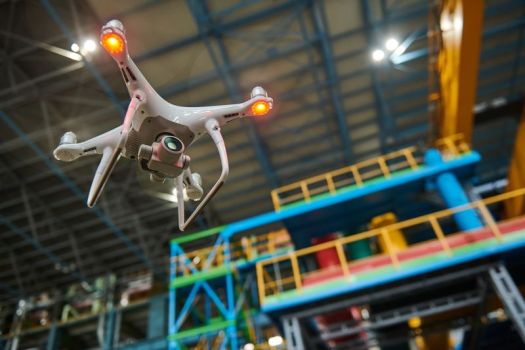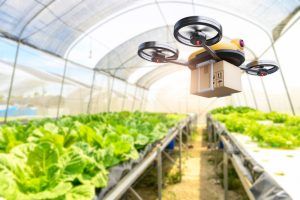Can I fly a drone/UAV indoors using a GPS repeater?

While commonly referred to as “drones”, this aeronautical sector uses many different names and acronyms to describe unmanned aerial systems.
Including, but not limited to:
- UAV – Unmanned Aerial Vehicle
- UAS – Unmanned Air/Aircraft System
- RPAS – Remotely Piloted Aircraft System
Regardless of its name or role, in most cases GNSS/GPS signals are used to determine the position of the UAV, track its movements, and assist it to maintain a hover.
GNSS or GPS – what’s the difference?
Drones are extremely useful in a number of applications, including crowd control, infrastructure inspections, search and rescue and agriculture – to name but a few.
The drone in the photo is transporting customer orders in a commercial greenhouse, and is most likely using “live” GPS signals that enter through the RF-transparent plastic roof.
But do they work indoors where there is no GPS signal?
It’s easy to see how a drone would be useful in a building, especially when used by emergency services during a disaster response.
However, if a UAV is to be used indoors, there may be no “natural” GPS signal present, because the signal can’t penetrate into the indoor space due to the blocking effect of the structure.
After all, the signal has traveled 12,500 miles down from the satellites and is already very weak when it gets to sea-level. The average signal strength outdoors is -130dBm.
Even slightly degraded signal strength can cause positional accuracy to decrease rapidly. Degradation, or complete loss, of the GPS signal will decrease the accuracy of location data and ultimately could force the vehicle to terminate its navigation until a human intervenes or it crashes.
Some UAVs can be manually flown, with on-board cameras relaying the view from the drone back to the controller over a radio link, but lack of GPS signal forces a different approach.
Could a drone be flown indoors using signal from a GPS repeater?
A single repeater unit, mounted 10 meters up in the ceiling, facing down, will provide signal over an area of around 35-40 meters diameter.
Thing is, wherever you are within the coverage area you will only pick up the (fixed) positional coordinates of the outdoor antenna: longitude, latitude, elevation = outdoor antenna location.
A drone can get confused, because when it moves it is still receiving the same GPS coordinates as if it was standing still.
So this doesn’t provide the means to navigate inside the building as the signal is the same wherever you are.
Signal from a repeater can be used for functional testing, but usually not for indoor flight/navigation.
For applications that require indoor signal, for example to enable functional testing, we have a range of repeater kits available.
For more information, please get in touch and let us know your requirements.

